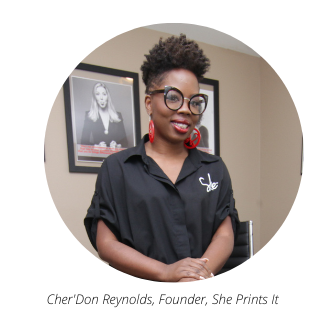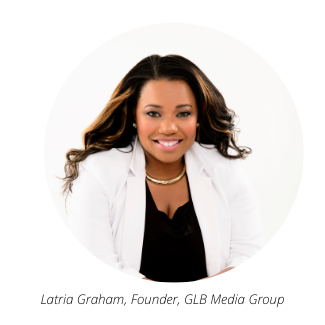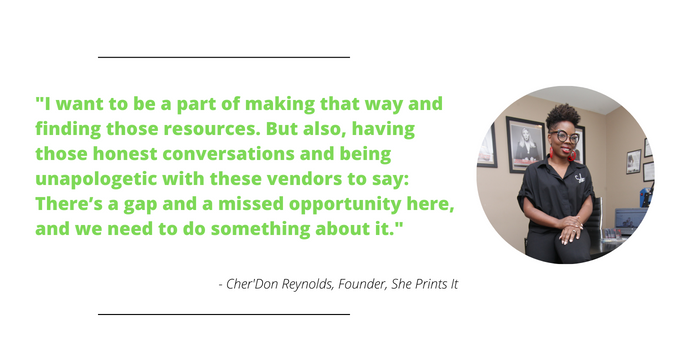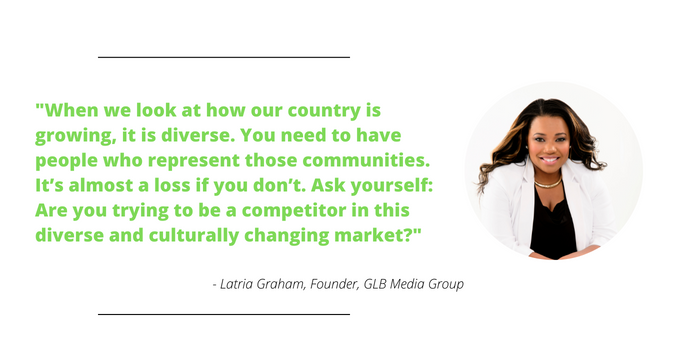How Black Promo Pros Are Creating Space For Themselves And The Next Generation

Being a minority in the promo industry is no different than anywhere else. “It’s dominated by white men, minority opportunities are usually given to white women, and you’re just trying to find your space in the midst of all of that,” says Cher’Don Reynolds, CEO and founder of She Prints It.
According to a 2020 ANA report, the entire marketing and advertising industry doesn’t look much different. In 2019, executives at major agencies were between 82% and 85% white, and only 3% of chief marketing officers were Black.
For Latria Graham, CEO and founder of GLB Media Group, her first major trade show was the real eye-opening experience. She says, “It was like ‘Woah!’ I didn’t realize the industry was so big, No. 1. But then I realized how many Black people were not in the industry or how few minority companies were participating.”
But Reynolds says, its not a new experience. “It’s definitely challenging, but it’s almost like you’re prepared for it being a minority born in America.”

Reynolds opened her distributorship in 2017 with a goal of helping other women-owned businesses. She says she loves being a part of the industry. “I love bringing visions to life, I love working with clients and finding partners who can help me create those visions.”
Graham, who opened her distributorship in 2016, says being a part of this industry is like joining a fraternity or a sorority. “It’s like a close community of people who get together and get excited about what products can do to activate brands,” she says.
However, getting started in this relationship-oriented industry is difficult. “Most promotional products companies that you see have been established for generations,” Reynolds says. “Their relationships and their systems are already in place.”
For Black promo pros, that means being behind before you even get started. “We are behind the 8-ball. There’s a lot that we don’t know because my company was not passed down to me. There wasn’t someone who already laid out all the relationship or had all the contacts ready. I wasn’t handed a turn-key business.”

And those supplier relationships are crucial. “We use a lot of different vendors. But I know others who are not people of color, and they have set aside account reps and people who are working with them exclusively, and they’re giving them 30- and 60-day nets. If you get a large account or client, and they’re operating on a 30- and 60-day net, but that supplier won’t give you a 30- and 60-day net, you have to have the cash flow.”
But Reynolds has never been offered opportunities like those. She says, “When I went to a conference last year, there was a guy saying how he just called his supplier up to print something for a presentation to his client. I was mindblown, thinking, “Who is doing this?” But when I looked around the room, everyone is nodding their heads. I didn’t even know that level of relationship even could exist.”
Sharing those opportunities with smaller distributors means suppliers taking chances and offering grace. “Our success is their success,” Reynolds says. “But if they don’t even think you are going to be successful in the first place, they are not going to invest you.”

But if there’s a will, there’s a way. “I want to be a part of making that way and finding those resources,” she says. “But also, having those honest conversations and being unapologetic with these vendors to say: There’s a gap and a missed opportunity here, and we need to do something about it.’”
Those missed opportunities happen in person, too. Reynolds says, “At one industry conference, there were some vendors who we’d already done business with, but when we went to their booth, they wouldn’t acknowledge us and instead, spoke to the white people behind me.”
Those moments stick with you. She says, “Just being asked, ‘What company do you work for?’ Then, I identify myself as the owner and they’re in disbelief like, ‘So you own it?’ Those subtle moments of racism or bias—and it’s literally people not acknowledging you as human—happen more often than not.”
But that doesn’t deter Reynolds. “Its safer to go into places where you are accepted. But I want to be a part of making this a safer space. I am willing to go through the struggles, challenges, sacrifices and the crazy looks so that it is a safe space for us in the future.”
In 2020, PPAI released a Diversity, Equity and Inclusion Playbook to help members take practical, powerful steps within their organizations. The Association has also developed a DEI Task Force focused on educating the industry on how strengthening business partner diversity, equity and inclusion will, in turn, strengthen what the industry has to offer.
Graham says, “I do think there is, at least in our Association, an inviting environment to welcome other Black-owned companies into the industry.”

For more Black people to join and be in engaged in this industry, Graham says visual marketing is priceless. “When you look at the industry across the associations, you don’t see minorities of color in positions of leadership. In recruiting talent, people must be able to see themselves in that industry or organization, or people that are relatable to them. That’s how we work as humans in our need for a sense of belonging,” she says. “There’s definitely opportunity for development in DEI at the top level.”
Graham says diversity is not just about ‘doing the right thing, it’s about doing good business.’ She says, “When we look at how our country is growing, it is culturally diverse. It’s good tp have leaders and business partners who represent those communities. You can lose future customers if continuously ignored. Ask yourself: Are you trying to be a competitor in this culturally diverse changing market or remain status quo? In order to compete, having cultural competency strategies beyond race-based quotas will be critical to your business growth.”
Both Reynolds and Graham hope to be a part of the community that’s creating space for the next generation of Black promo pros. To do that, they’re partnering with other people of color who are committed to doing the work.
Reynolds says, “This is an industry that will never die. Whether we use social media or billboards, there’s always a need for those tangibles to remind people that you are there. We know that it’s a safe space to be in. It’s one of the few industries that didn’t die during the pandemic. In this [$22] billion-dollar industry, we deserve to have a seat at the table.”

